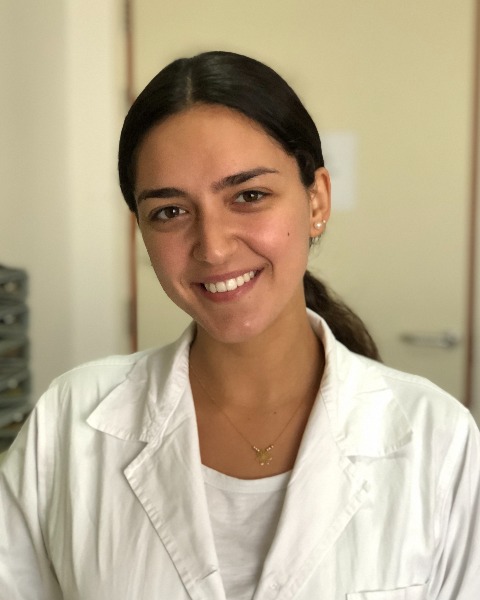Tuesday Poster Session
Category: Endoscopy Video Forum
P3881 - Light at the End of the Tunnel - Establishing Esophageal Lumen After Complete Radiation-Induced Esophageal Obstruction
Tuesday, October 29, 2024
10:30 AM - 4:00 PM ET
Location: Exhibit Hall E

Has Audio

Joelle Sleiman, MD
Staten Island University Hospital, Northwell Health
Staten Island, NY
Presenting Author(s)
Joelle Sleiman, MD, Hassan Al Moussawi, MD, Sherif Andrawes, MD
Staten Island University Hospital, Northwell Health, Staten Island, NY
Introduction: Esophageal stricture is a well-recognized late adverse event of head, neck, or thoracic radiation. Radiation-induced stricture develops 3 to 8 months after completion of radiation therapy. Herein we present a case of radiation induced esophageal obstruction that was successfully treated using retrograde and anterograde endoscope “Kissing” technique.
Case Description/Methods: 67-year-old man with history of squamous cell carcinoma of the parotid status post-chemo and radiotherapy, history of percutaneous endoscopic gastrostomy (PEG) tube presented for evaluation of inability to tolerate oral secretions. Using the neonatal endoscope ,the esophagus could not be intubated as there was a complete obstruction at the level of the upper esophageal sphincter. As a result, we elected to pass the neonatal scope through the patient's pre-existing PEG tube. PEG tube was removed and the neonatal scope was passed through the PEG tract in a retrograde fashion. The upper esophagus was reached and was noted to be completely obstructed. Another standard endoscope was passed through the mouth( antegrade scope) . Using the antegrade scope, the light of the neonatal scope was noted across the obstructed lumen with the help of trans-illumination and scope apposition was confirmed using fluoroscopy. Using an dual endoscopic submucosal dissection knife through the antegrade scope, a careful dissection was made until the neonatal scope was seen. The neonatal scope was passed through the dissected opening restoring the patency of the esophagus. The antegrade standard endoscope then followed the retrograde neonatal scope through the lumen. The neonatal scope was then removed. A Savary wire was then passed through the antegrade scope and the scope was exchanged to a 14 mm Savary dilator, successfully dilating the esophagus. Finally, a 15 x 10 mm lumen apposing AXIOS stent was placed in the upper esophagus and correct placement was confirmed endoscopically and fluoroscopically. Patient was able to tolerate clear liquid diet after several months of being NPO.
Discussion: Esophageal lumen can be restored after complete radiation induced esophageal obstruction using retrograde and anterograde endoscope “Kissing” technique
Disclosures:
Joelle Sleiman, MD, Hassan Al Moussawi, MD, Sherif Andrawes, MD. P3881 - Light at the End of the Tunnel - Establishing Esophageal Lumen After Complete Radiation-Induced Esophageal Obstruction, ACG 2024 Annual Scientific Meeting Abstracts. Philadelphia, PA: American College of Gastroenterology.
Staten Island University Hospital, Northwell Health, Staten Island, NY
Introduction: Esophageal stricture is a well-recognized late adverse event of head, neck, or thoracic radiation. Radiation-induced stricture develops 3 to 8 months after completion of radiation therapy. Herein we present a case of radiation induced esophageal obstruction that was successfully treated using retrograde and anterograde endoscope “Kissing” technique.
Case Description/Methods: 67-year-old man with history of squamous cell carcinoma of the parotid status post-chemo and radiotherapy, history of percutaneous endoscopic gastrostomy (PEG) tube presented for evaluation of inability to tolerate oral secretions. Using the neonatal endoscope ,the esophagus could not be intubated as there was a complete obstruction at the level of the upper esophageal sphincter. As a result, we elected to pass the neonatal scope through the patient's pre-existing PEG tube. PEG tube was removed and the neonatal scope was passed through the PEG tract in a retrograde fashion. The upper esophagus was reached and was noted to be completely obstructed. Another standard endoscope was passed through the mouth( antegrade scope) . Using the antegrade scope, the light of the neonatal scope was noted across the obstructed lumen with the help of trans-illumination and scope apposition was confirmed using fluoroscopy. Using an dual endoscopic submucosal dissection knife through the antegrade scope, a careful dissection was made until the neonatal scope was seen. The neonatal scope was passed through the dissected opening restoring the patency of the esophagus. The antegrade standard endoscope then followed the retrograde neonatal scope through the lumen. The neonatal scope was then removed. A Savary wire was then passed through the antegrade scope and the scope was exchanged to a 14 mm Savary dilator, successfully dilating the esophagus. Finally, a 15 x 10 mm lumen apposing AXIOS stent was placed in the upper esophagus and correct placement was confirmed endoscopically and fluoroscopically. Patient was able to tolerate clear liquid diet after several months of being NPO.
Discussion: Esophageal lumen can be restored after complete radiation induced esophageal obstruction using retrograde and anterograde endoscope “Kissing” technique
Disclosures:
Joelle Sleiman indicated no relevant financial relationships.
Hassan Al Moussawi indicated no relevant financial relationships.
Sherif Andrawes indicated no relevant financial relationships.
Joelle Sleiman, MD, Hassan Al Moussawi, MD, Sherif Andrawes, MD. P3881 - Light at the End of the Tunnel - Establishing Esophageal Lumen After Complete Radiation-Induced Esophageal Obstruction, ACG 2024 Annual Scientific Meeting Abstracts. Philadelphia, PA: American College of Gastroenterology.
